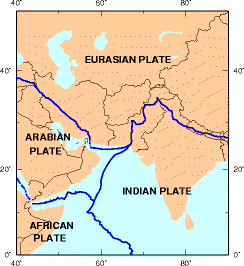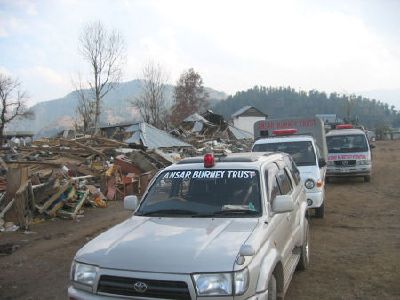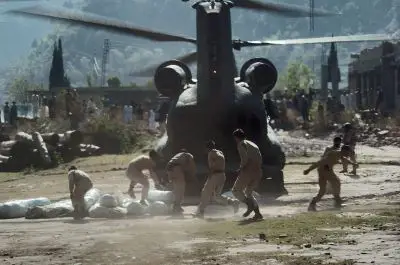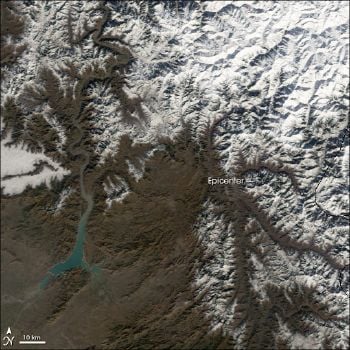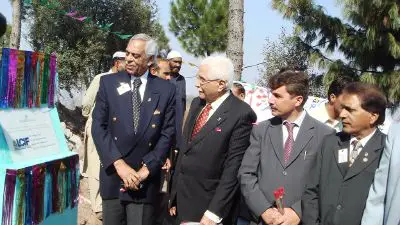2005 Kashmir earthquake
| 2005 Kashmir Earthquake | ||
|---|---|---|
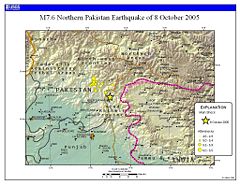
| ||
| Date | October 8 2005 | |
| Magnitude | 7.6 Mw | |
| Depth | 10km | |
| Epicenter location | Muzaffarabad | |
| Countries affected | Pakistan, India, Afghanistan | |
| Casualties | 74,500+ dead 106,000+ injured | |
The Kashmir earthquake (also known as the South Asian earthquake or the Great Pakistan earthquake) of 2005, designates a major earthquake with its epicenter in the Pakistan-administered Kashmir. The earthquake occurred at 08:50:38 Pakistan Standard Time (03:50:38 UTC) on October 8, 2005. Registering a debatable 7.7 or 7.6 on the Richter scale, the quake compares in intensity to the 1935 Quetta earthquake, the 2001 Gujarat earthquake, and the 1906 San Francisco earthquake.
In response to the catastrophe, India and Pakistan dropped their hostility over the Kashmir region and cooperated in relief efforts. Instead of armies braving the harsh and forbidding terrain at the beginning of winter to fight each other, they braved the elements to bring assistance to the people of Northern Pakistan and Kashmir. The Pakistan and India governments welcomed the assistance of the United States Air Force and United States Army. The United States launched a massive operation to bring relief to the quake devastated region. Feelings toward the United States in the region had been bitter because of the War on Terrorism in Pakistan, Afghanistan, and Iraq. The U.S. participation in relief efforts, coupled with Indian and Pakistani cooperation, saved countless lives.
Human impact
Most of the affected people lived in mountainous regions with access impeded by landslides that blocked the roads, leaving an estimated 3.3 million homeless in Pakistan. The UN reported that the quake directly affected 4 million people, occurring prior to the commencement of winter snowfall in the Himalayan region. Damages incurred were estimated at US$ 3.5 billion. [1] India and Pakistan opened five crossing points on the Line of Control (LoC) to facilitate the flow of humanitarian and medical aid to the affected region. International aid teams from around the world came to the region to assist in relief.[2]
The earthquake
Kashmir lies in the area of collision of the Eurasian and Indian tectonic plates. The geological activity that precipitated the collision, lay at the root of unstable seismicity in the region. The activity also has been responsible for the birth of the Himalayan mountain range. The United States Geological Survey (USGS) measured its magnitude as a minimum of 7.6 on the moment magnitude scale, with its epicenter about 19 km (11.8 miles) northeast of Muzaffarabad, Pakistan, and 100 km (65 miles) north-northeast of the national capital Islamabad. The USGS has classified the earthquake as "major." The Japan Meteorological Agency estimated its magnitude at a minimum of 7.8. By comparison, the 2004 Indian Ocean earthquake had a magnitude of 9.15.
The earthquake caused widespread destruction in northern Pakistan, as well as damage in Afghanistan and northern India. Pakistan-administered Kashmir, Pakistan's North-West Frontier Province (NWFP), western and southern parts of the Kashmir valley in the Indian Kashmir came out as the worst hit areas. Some parts of the Pakistani province of Punjab, the capital city of Islamabad, and the city of Karachi experienced a minor aftershock of magnitude 4.6. Many secondary earthquakes shook in the region, mainly to the northwest of the original epicenter. A total of 147 aftershocks had been registered in the first day after the initial quake, one recording a magnitude of 6.2. Twenty-eight of those aftershocks occurred with magnitudes greater. On October 19, a series of strong aftershocks, one with a magnitude of 5.8, occurred about 65 km (40.5 miles) north-northwest of Muzaffarabad. More than 978 aftershocks with a magnitude of 4.0 and above shook the region.
Casualties
| 2005 Kashmir earthquake casualties | |||
| Location | Dead | Injured | |
| Pakistan (NWFP & Kashmir) | 73,338     | 100,000     | |
| India (Kashmir) | 1,360      | 6,266 | |
| Afghanistan | 4      | 14 | |
| Total | 74,500+ | 106,000+ | |
Most of the casualties resulting from the earthquake occurred in Pakistan where the official confirmed death toll stands at 74,698, registering higher than the massive scale of destruction of the Quetta earthquake of May 31, 1935. Nearly 1,400 people died in Indian-administered Kashmir, according to officials.[3] International donors have estimated that about 86,000 died. Pakistani authorities have neither confirmed or endorsed those numbers.
With Saturday a normal school day in the region, most students attended school when the earthquake struck. Collapsing school buildings buried many students. Occurring during the month of Ramadan, the quake caught most people napping in their homes after their pre-dawn meal. Trapped in their homes, without time to escape during the earthquake, they perished in the rumble. Reports indicate that the quake completely wiped out entire towns and villages in Northern Pakistan. Surrounding areas also suffering severe damage. Kofi Annan warned that there were tens of thousands more in need of help:
What is impossible for any picture to convey is the sheer magnitude of this catastrophe. In the most affected area, which covers some 28,000 square kilometres of Pakistan, all essential infrastructure has been destroyed. That means thousands of hospitals and schools; government buildings and water systems; major roads and transport. ... Winter is approaching fast, and temperatures are dropping. The latest death toll stands at 42,000 with at least 67,000 injured. But because we still have not accessed hundreds of thousands of people in remote areas, we fear that the actual figures are far higher. And unlike some natural disasters, in which victims die immediately, the death toll in Pakistan is not over yet. An estimated 3 million men, women and children are homeless. Many of them have no blankets or tents to protect them against the merciless Himalayan winter. That means a second, massive wave of death will happen if we do not step up our efforts now. [4]
According to Pakistan's Interior Minister Aftab Sherpao, Prime Minister Shaukat Aziz "made the appeal to survivors" on October 26, to come down to valleys and cities for relief, because "bad weather, mountainous terrain, landslides, and blocked roads are making it difficult for relief workers to reach each house and the winter snows are imminent."[2]
Damage
Pakistan administered Kashmir
The Earthquake Engineering Center of the University of Engineering and Technology, Peshawar, assessment of damaged buildings in Muzaffarabad and the surrounding area revealed approximately 60 percent of the buildings in urban areas had been unreinforced solid concrete block masonry buildings. [1]
Pakistani television reported widespread severe damage to Balakot (almost completely wiped out), Garhi Habibullah, Rawalakot, and Muzaffarabad (near the epicenter) where and estimated 30,000 died. The Pakistani Army spokesman, Major General Shaukat Sultan, told a press conference on October 10 that reports of damage in Rawalakot had been exaggerated; 90 percent of the garrison city remained standing. The quake triggered landslides, burying entire villages and roads in many areas of North-West Frontier Province and Pakistan-administered Kashmir. Hundreds of thousands of buildings had been reported collapsed or sustained severe damage.
One of two residential towers (Margalla Towers in F-10 sector, Islamabad), believed to contain up to sixty apartments each, collapsed in the earthquake in Islamabad. Pakistani government officials at the site stated that hundreds of people had been affected by the collapse, most feared dead. Over fifty-two people had been rescued from the collapsed residential "Margalla Towers."
The quake blocked the Karakoram highway at several points, hindering relief efforts. Damage to buildings and several casualties have been reported in surrounding provinces of Punjab and NWFP.
Indian administered Kashmir
The quake destroyed 1,500 houses in Uri, affecting about 90% of the families in the town of 30,000. More than 1,100 houses had been flattened in Jammu and Kashmir. The main minaret of the Hazratbal shrine, believed to house a relic of the prophet Muhammad, suffered damage.[5] The 200-year-old Moti Mahal fort in Poonch district, Kashmir, collapsed.[6]
Buildings in Delhi and Amritsar experienced damage, and tremors caused panic in Gujarat. People in Uttar Pradesh, Uttaranchal, Himachal Pradesh, Rajasthan, and Madhya Pradesh felt the tremors. Over 1300 died.
Afghan territory
Four deaths had been reported in Afghanistan, including a young girl who died in Jalalabad after a wall collapsed on her. People felt the quake in Kabul, with minimal effects.
Rescue and relief operations
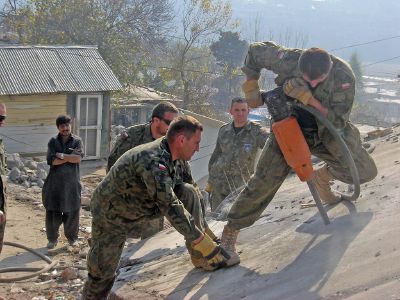
Roads buried in rubble hampered relief efforts in many remote villages and many affected areas remained inaccessible. Rescuers lacked the heavy equipment, needed to clear the roads and to rescue survivors buried under the earthquake wreckage. Many rescuers picked the rubble with pickaxes and their bare hands, looking for survivors.
Numerous aftershocks that continued to rattle the region affected rescue efforts put rescue workers in danger as they searched through the wreckage for survivors. India and Pakistan opened five crossing points on the Line of Control (LoC) between in the province of Kashmir. The first opened at Chakan Da Bagh in Poonch, the second at Kaman Post in Uri (on the road between Srinagar and Muzaffarabad) and the third across the Neelum river between Chiliana in Pakistan and Tithwal in India. Those border crossings facilitated the flow of relief goods and allowed people to meet relatives across the Line of Control.
In many areas power went out while people also lacked adequate food or water. The danger of disease spreading, including measles, increased dramatically. Distributing relief supplies to the victims became especially urgent as the victims, living at high altitude and with the approaching winter, faced the risk of exposure to cold weather. Relief workers identified food, medicine supplies, tents and blankets as essential items. On October 10, the United Nations warned that the earthquake left 2.5 million people homeless and they needed shelter. The UN made an appeal to raise US$272 million to help victims.
On October 13, snow started to fall on the Indian side of Kashmir. Many regions faced an increasing threat of being cut off from help as snow forced closures of even more roads in the mountainous region.
Pakistan
In Northern Pakistan and Pakistan-administered Kashmir, the Pakistan Army supervised an immediate assessment of the extent of damage. The Government of Pakistan opened President's Relief Fund for Earthquake relief operation, and also appealed for International Aid. They appealed for blankets, tents, medicine, warm clothes, food and many more supplies. Pakistan International Airlines (PIA) offered free delivery of goods from anywhere in the world to Pakistan. Turkey offered to airlift relief goods that arrive in Turkey to Pakistan free of cost.
Pakistani Prime Minister Shaukat Aziz spoke on the telephone with authorities in four provinces plus Azad Kashmir, directing them to utilize all available resources, including machinery, to help the victims. He said the entire federal administration, civil and military authorities had been alerted, and relief goods had been provided to them for the victims of the quake. Most of the roads had been closed in the Northern Sector near the earthquake, some completely washed out or blocked by landslides. That forced the Pakistani army to fly supplies in by helicopter.
In Garhi Habibullah, a town 205 miles (328 km) from the devastated city of Balakot in north-west Pakistan, a few Kashmiri mujahideen put aside their weapons, spending two days helping rescue dozens of girls trapped in a collapsed building of a girls' school. Some militant groups operating in Kashmir continued to attack and kill Indian soldiers in the Indian state of Jammu and Kashmir.
Soon after the earthquake struck, NGO's started their relief efforts. Kashmir Relief and Development Foundation (KRDF), a UK based charity setup relief camps in all the major cities of Azad Jammu Kashmir and KRDF volunteers worked around the clock to help the earthquake victims. That included distribution of tents, food supplies, clothing and shelter with the help of individuals and various organizations.
On October 10, Monday, rescuers still found survivors, including a 2-year-old girl in Islamabad. Then on Wednesday, a Russian rescue team rescued a 5-year-old girl in Muzaffarabad trapped for nearly 100 hours.
On October 14, the Pakistan government agreed that unaccompanied children from the disaster should be taken to the SOS Children emergency shelter in Islamabad for family tracing in a central database. They created a credit program for affected families. They also agreed that SOS should be temporary guardian until relatives could be traced.
The Pakistani people from all regions and walks of life generously donated relief supplies in both goods and money for the earthquake victims. The magnitude of that disaster found the Government alone unable to provide relief to the people affected by this earthquake. Appeals to the people of Pakistan to help the government in its relief efforts brought needed donations, relief goods and volunteers to work in the hospitals and the earthquake hit areas. Helicopters ferried the injured from remote areas to the hospitals of Rawalpindi and Islamabad every day. Relatives of the injured traveled to the twin-cities by road; they experienced a long and painful search for their loved ones. Devastated with heavy losses of human lives and homes, those poor people often traveled on foot from one hospital to another looking for their injured loved ones. Three surgeons from Harley Street went out for a week to help with the victims of the earthquake and set up a field hospital in the town of Bagh.
In the midst of the disaster, Focus Humanitarian Assistance (FOCUS), an agency affiliated with the Aga Khan Development Network (AKDN) responded by mobilizing specialized staff, volunteers and resources. FOCUS conducted search and rescue operations and distributed essential relief items to tens of thousands of families in the affected areas of Islamabad, Muzaffarabad, and other remote regions of the country. To assist in the operations, FOCUS used four AKDN helicopters, making numerous trips into the affected area. They carried relief items including staple foods such as oil, lentils and rice, as well as tents, blankets and medical supplies, distributing them to thousands. On their return journeys to Islamabad, the helicopters, along with numerous U.S. military helicopters, carried survivors requiring urgent medical assistance.[7] In recognition of their rescue and relief efforts, FOCUS received the Sitara-e-Eisaar, conferred by President of Pakistan, General Pervez Musharraf on June 30, 2006.[8] A large number of American, European, and Asian nonprofits also entered the region and mounted a massive relief operation.
In late 2006, Pakistan approved $20 billion development scheme for reconstruction of the earth-quake hit zones in Azad Kashmir.[9] A land use plan for Muzaffarabad city had been prepared by Japan International Cooperation Agency.
Pakistan established the Earthquake Reconstruction & Rehabilitation Authority to rebuild the area.
India
In the Indian-administered Jammu and Kashmir, rescuers bring the injured to Srinagar's SMHS hospital and the Uri Field Hospital for treatment. Many makeshift medical facilities had been set up to help the injured. Hundreds of people had been brought in, many of them critically injured. In keeping with a traditional duty since independence, the Indian Army has undertaken a key role in coordinating and running relief operations.
Indian Prime Minister Manmohan Singh, and Leader of the Opposition L.K. Advani visited quake-hit areas.[10] The Prime Minister's National Relief Fund released an ex gratia of Rs one lakh (100,000 Indian rupees, about US$2255) to the next of kin of those killed in the quake.
International response
Many countries, international organizations and non-governmental organizations offered relief aid to the region, in the form of donation as well as relief supplies including food, medical supplies, tents and blankets. Rescue and relief workers came to the region from different parts of the world bringing rescue equipment, including helicopters and rescue dogs. The United Nations appealed for donations of US$272 million to help victims of the quake.
The International Association of Lions Clubs (LCI) & Lions Clubs International Foundation (LCIF) donated an amount of US$892,000 for the reconstruction of 150 houses along with supporting infrastructure and a water supply system at Village Anwar Sharif, Muzaffarabad, and Azad Kashmir.
The International Director of Lions Clubs International, Lion Malik Khuda Baksh handed over the houses to their occupants on July 26, 2007. Mr. Raja Zulqarnain Khan, President of the Azad Kashmir attended as the Chief Guest of the Ceremony. A team of volunteer New York City paramedics traveled to the remote villages of Kashmir two weeks after the earthquake and treated over 200 patients a day in a two week relief effort.[11] Many international relief organizations served for an extended time, particularly in the hard hit areas of NWFP and rural Kashmir.
Notes
- ‚ÜĎ 1.0 1.1 The Kashmir earthquake of October 8, 2005: Impacts in Pakistan Earthquake Engineering Research Institute, February 28, 2006. Retrieved December 19, 2022.
- ‚ÜĎ 2.0 2.1 Khalid Qayum, "Pakistan Asks Quake Survivors to Leave Mountains Before Winter." Bloomberg, October 26, 2005. Retrieved December 16, 2022.
- ‚ÜĎ Earthquake toll leaps to 73,000 BBC, November 3, 2005. Retrieved December 19, 2022.
- ‚ÜĎ Transcript of Press Conference by Secretary-General Kofi Annan at United Nations Headquarters, 19 October 2005 United Nations Information Service, October 20, 2005 Retrieved December 19, 2022.
- ‚ÜĎ Mukhtar Ahmad and Onkar Singh, Nearly 300 killed as quake jolts J&K, Hazratbal tower damaged Rediff, October 8, 2005. Retrieved December 19, 2022.
- ‚ÜĎ Hundreds die in South Asia quake BBC, October 8, 2005. Retrieved December 19, 2022.
- ‚ÜĎ AKDN, Focus Humanitarian Assistance Mobilises Support for Thousands Affected by Asia Earthquake. Retrieved October 10, 2017.
- ‚ÜĎ FOCUS Humanitarian Relief Pakistan received Earthquake Relief Award AKDN, October¬†15, 2007. Retrieved December 19, 2022.
- ‚ÜĎ Rs1.25 trillion to be spent in Azad Kashmir: Reconstruction in quake-hit zone Dawn Pakistan, October 1, 2006. Retrieved December 19, 2022.
- ‚ÜĎ PM, Advani to visit quake-hit areas Rediff, October 10, 2005. Retrieved December 19, 2022.
- ‚ÜĎ Pakistan NYC Medics. Retrieved December 19, 2022.
ReferencesISBN links support NWE through referral fees
- Banerjee, Dipankar, and D. Suba Chandran. Jammu and Kashmir After the Earthquake: Preparing for a New Beginning. New Delhi: SaŠĻĀskŠĻõiti in association with Institute of Peace and Conflict Studies, 2007.
- Durrani, Ahmad Jan, Amr Salah Elnashai, Youssef M. A. Hashash, Sung Jig Kim, and Arif Masud. The Kashmir Earthquake of October 8, 2005: A Quick Look Report. MAE Center report. Urbana-Champaign, IL: Mid-America Earthquake Center, 2005. OCLC 65167442
- Harp, Edwin L., and Anthony J. Crone. Landslides triggered by the October 8, 2005, Pakistan earthquake and associated landslide-dammed reservoirs. Reston, VA: U.S. Geological Survey, 2006. Retrieved Decemebr 19, 2022.
- Renner, Michael, Zo√ę Chafe, and Lisa Mastny. Beyond Disasters: Creating Opportunities for Peace. Worldwatch report. Washington, DC: Worldwatch Institute, 2007. OCLC 153294338
External links
All links retrieved June 13, 2023.
- Special Event Page, Amateur Seismic Centre, India.
- When the Earth Moved Kashmir
- Photo journal: Earthquake in Uri Village BBC News, October 10, 2005.
- Photo journal: Return to Uri Village BBC News, October 31, 2005.
- Rich world 'failing' on quake aid BBC News, October 26, 2005.
- Quake 'is UN's worst nightmare' BBC, October 20, 2005.
- Kashmir prized but little aided Christian Science Monitor, October 14, 2005.
- Quake highlights kashmir dispute BBC News, December 21, 2005.
Credits
New World Encyclopedia writers and editors rewrote and completed the Wikipedia article in accordance with New World Encyclopedia standards. This article abides by terms of the Creative Commons CC-by-sa 3.0 License (CC-by-sa), which may be used and disseminated with proper attribution. Credit is due under the terms of this license that can reference both the New World Encyclopedia contributors and the selfless volunteer contributors of the Wikimedia Foundation. To cite this article click here for a list of acceptable citing formats.The history of earlier contributions by wikipedians is accessible to researchers here:
The history of this article since it was imported to New World Encyclopedia:
Note: Some restrictions may apply to use of individual images which are separately licensed.
